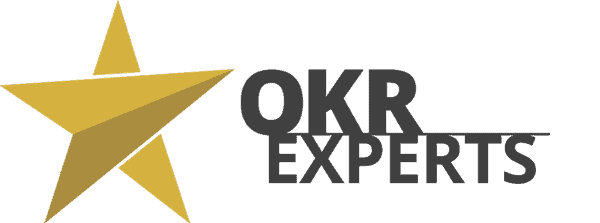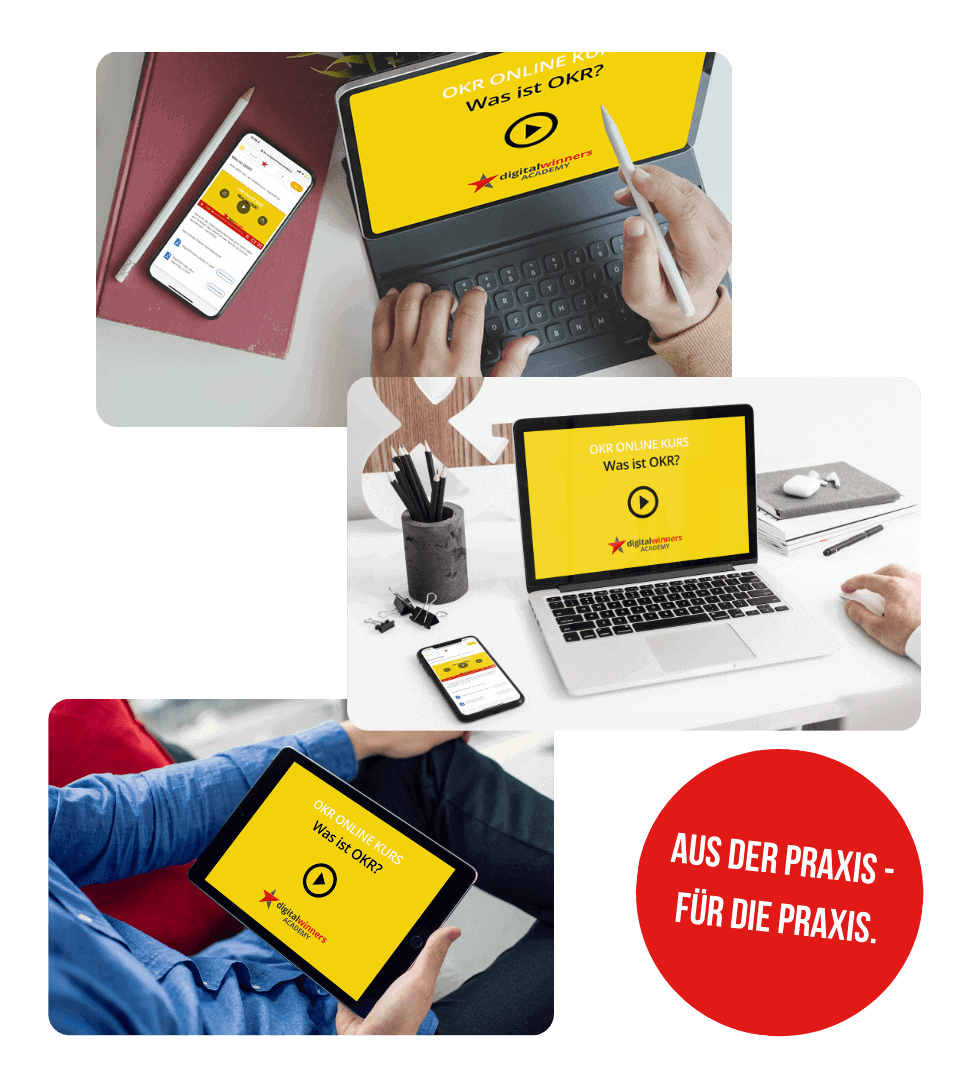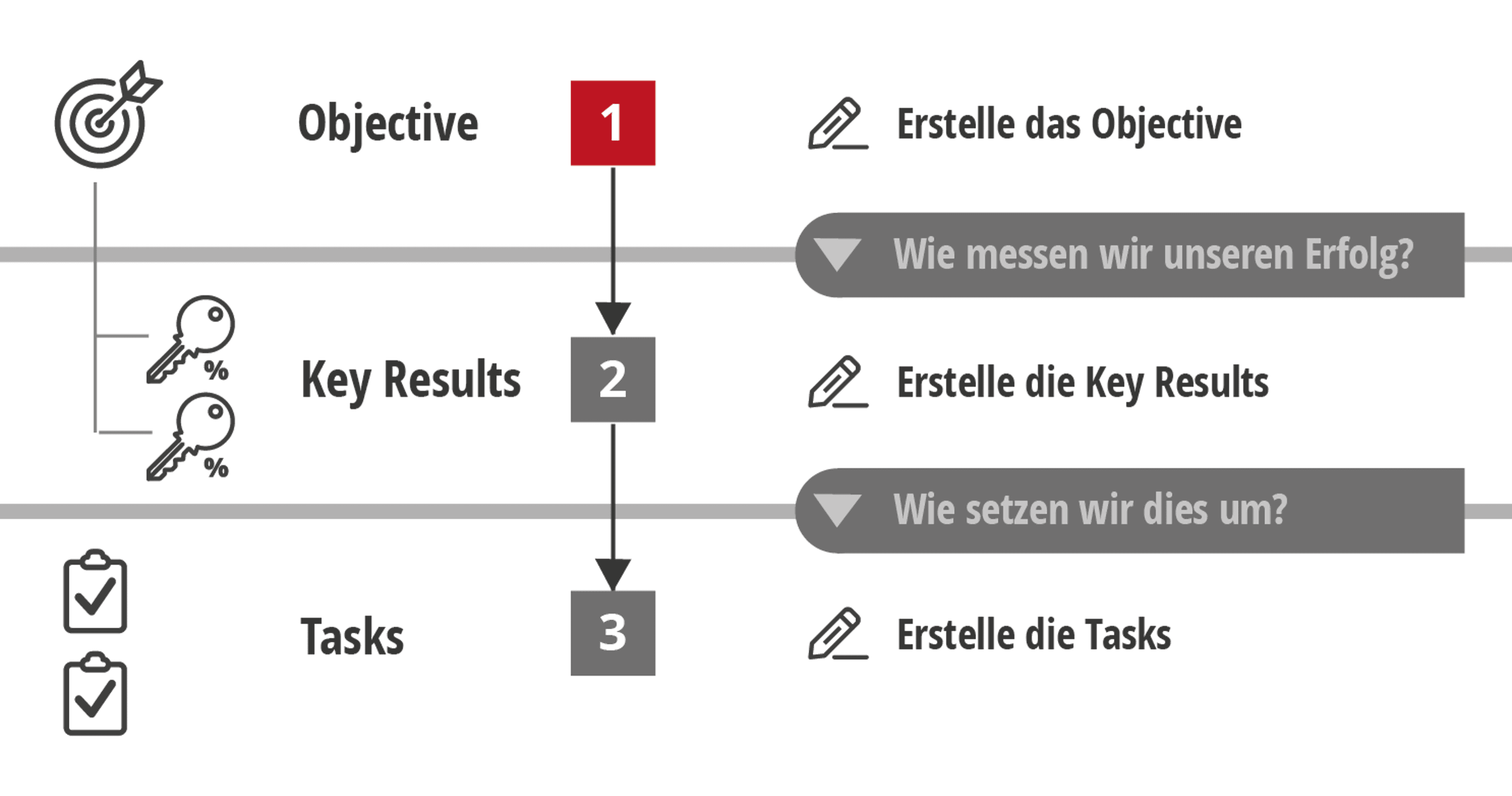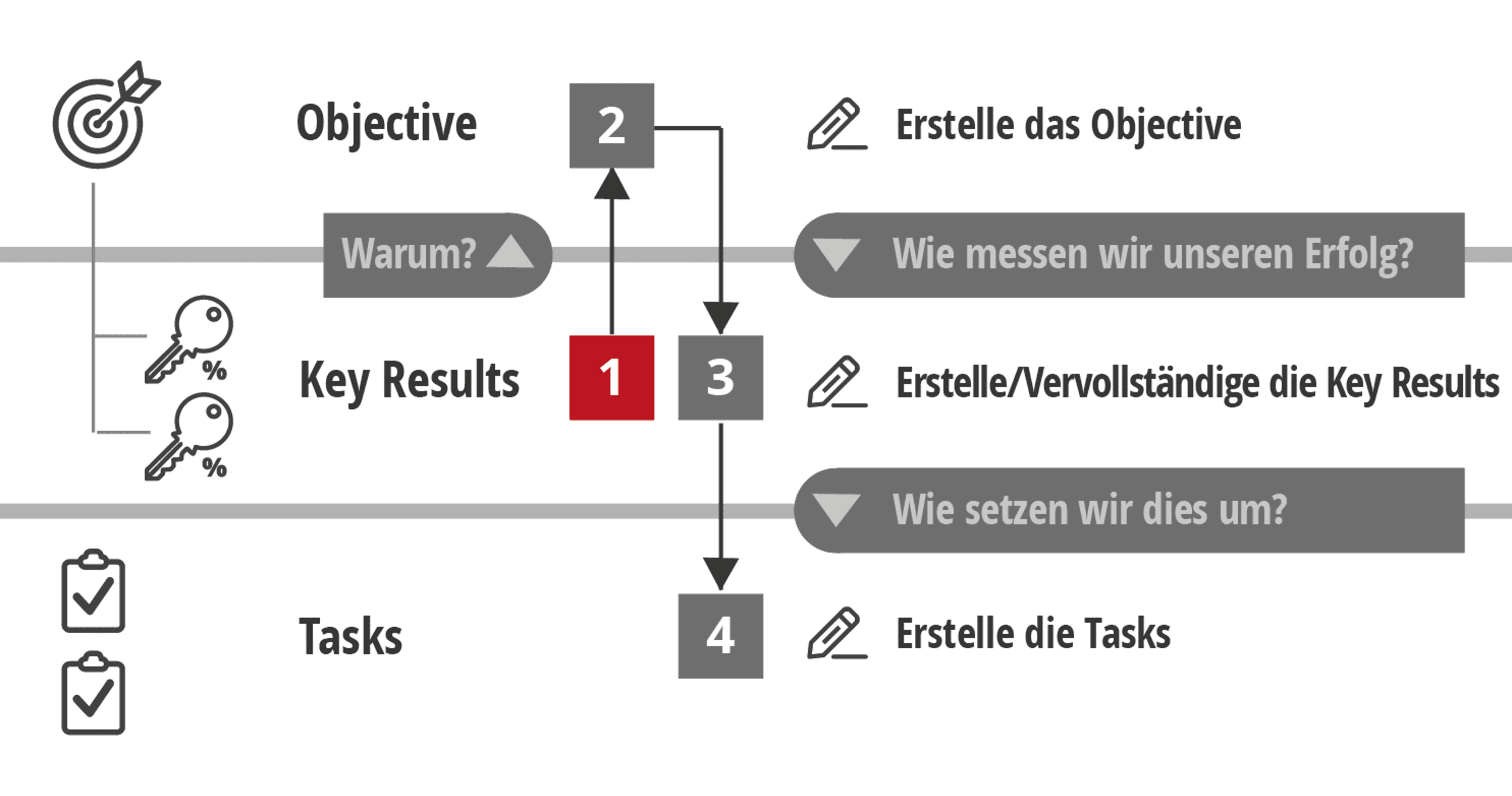OKR examples
Creating optimal OKR examples is not so easy – even if the creation of OKR sets seems simple at first glance.
Whether you review the standard literature by John Doerr (investment manager at venture capitalist Kleiner Perkins, who introduced OKR to Google in 1999 and learned about OKR from Andy Grove) or the websites of other OKR experts, the OKR examples are usually less than optimal or inconsistent, if not confusing.
But what do optimal OKR examples: optimal objectives and key results – OKR sets look like that do justice to the spirit of the inventor of the OKR method, Andy Grove?
You can find more information on the OKR method in the basic article OKR method – from the history to the explanation of what an objective and key result is, to the OKR cycle, the OKR meetings: OKR Planning, OKR Weekly, OKR Review and OKR Retrospective.
What do good OKRs look like?
An objective should be a qualitative, results-oriented, ambitious and inspiring goal that describes what needs to be achieved – a key result is a quantitative key result that describes how we achieve the goal and clearly states whether the goal has been achieved. Both objectives and key results describe the “outcome”, the benefit or value contribution and not the “output” or tasks. More on this in the article OKR Method.
What are examples of OKR?
Here is an OKR example of a restaurant.
Situation:
- Despite enormous marketing efforts, we have not achieved any notable successes, such as an increase in sales, an increase in gross profit or higher capacity utilization on working days.
- Now we want to launch an offensive that will make us more successful without further marketing expenditure.
Strategic thrust and strategic initiatives:
- Recommendations: Service staff recommend starters and desserts, as well as suitable drinks,
- satisfied customers recommend new customers,
- Increase in guest satisfaction.
Financial targets (business plan, 1 year): all figures net:
Increase in the average
- Turnover per guest: drinks from €9 to €15 and food from €19 to €25,
- Gross profit (contribution margin 1 = DB1 = net turnover – net cost of goods sold) per guest: drinks from €7 to €12 and food from €11 to €17.
The objective for our OKR example
The objective is formulated purely qualitatively, i.e. without metrics from the following building blocks:
- Target state / future state
- Role: Customer / user (internal / external)
- Value proposition / benefit
Objective: We have optimized our
all-round optimization of our offers and services
the culinary enjoyment and attractiveness of our offers for our guests.
our guests
and thus inspired them.
The key results for our OKR example
When formulating the key results, we make sure that these are
- contribute to the value contribution of the objective,
- are quantitative, i.e. contain metrics – the ideal formulation is always “from actual metrics to target metrics”, whereby the target metric is a kind of
promise
that is to be achieved at the end of the OKR cycle, - only contain lead metrics, i.e. lead indicators that can be influenced and no lag indicators,
- the “outcome”, the benefit, … and do not contain any concrete measures/tasks.
The objective is broken down into the success drivers by the key results or the (value) promises are broken down and made measurable.
Key Results:
- We have increased the
proportion of guests
who order a main course and a starter or dessert from 30% to
60%
in order to enrich and complete the culinary experience. - We have calculated the
average number of drinks per guest
from 1.8 to
2,5
to round off the culinary experience. - We have increased the
number of new guests
who come on the recommendation of regular guests from an average of 20 per week to
30 per week
in order to expand our regular clientele for a more even utilization and more sustainable sales. - We have the
Google rating
of our restaurant from 2.8 to
4.5 stars
to convince potential guests of our quality.
The complete OKR example thus looks as follows:
OKR example for a restaurant
OKR Seminar mit offizieller Zertifizierung zum OKR Coach / Master
Wir, die OKR-Experten, bilden Sie gerne zum OKR Coach / Master aus:
- in Präsenz & Remote
- Erlernen & Erleben der OKR-Methode
- Best Practices, Tipps & Tricks
The team initially considered the following measures/tasks to increase average sales per guest. These are to be tested and measured on a weekly basis to track whether the key results are developing positively. It is important that the measures/tasks are not at the expense of the guest, as the aim is also to increase guest satisfaction. The measures/tasks can change during the OKR cycle, but the objective and the key results should remain unchanged until the end of the OKR cycle and at the end of the OKR cycle an OKR review should be carried out to assess whether the objective has been achieved.
- More attractive starters and desserts,
- Different meals during the week and at the weekend,
- more seasonal, vegetarian and vegan dishes,
- Staff training on which drinks best suit the individual guest and the respective dishes, possibly seasonal (refreshing, warming, …), aperitifs, wines, liqueurs – with starters, main courses and desserts – alcoholic and non-alcoholic,
- Staff training on which starters and desserts are best suited to the individual guest and the respective main courses, possibly seasonal,
- Expand the range of drinks, especially for corporate events,
- Revision of the menu: Description of the dishes in the most appealing and appetizing way – and addition of specific wine recommendations: “We recommend …”,
- Checking prices for psychologically sensible prices.
What you can do wrong when creating goals with the OKR method
Well-intentioned OKR examples unfortunately often incorrectly describe tasks, such as the Objective example “Delivery of … [Bau-]parts to … by May 30″[1] or the Key Result example “I will finish my presentation on time.”[2].
Unfortunately, key results also often incorrectly contain no metrics, as in the example above – so it is often not possible to use the key results to determine whether the objective has been achieved in terms of the “outcomes”, the benefits or value contribution. For this reason, the metrics of the key results should be based on key performance indicators (KPIs) – but on lead indicators (leading indicators) and not on lag indicators (trailing indicators). Without metrics, the status of target achievement cannot be measured.
Other examples in the literature contain measures that extend beyond the OKR cycle, i.e. are not completed at the end of the OKR cycle. However, the aim is to achieve the targets – by the end of the OKR cycle at the latest. In addition, they are usually not very ambitious (see Moonshot Thinking).
[1] Book “OKR: Objectives & Key Results: How to develop, measure and implement goals that really matter”, John Doerr, p. 51
[2] ditto – p. 23
OKR set described in brief
For greater clarity, the OKR set can also be formulated in short form.
Do you start with the creation of objectives or with the creation of key results?
Top-level objectives are derived from the corporate strategy or strategic initiatives – departmental and team objectives are derived from key results at the level above.
If you find it difficult to create the objective, it is sometimes helpful to start with the key results that contribute to the “goal” and then derive and formulate the objective from these.
The same applies to the creation of key results: if necessary, first create tasks that contribute to the “goal” and then formulate the key result(s).
Free infographic
How to create optimal OKR sets – procedure
Download high-resolution PDF and numerous other e-books now.
How to move from task and “output” towards “outcome” when creating OKRs
To get closer to the “outcome”, ask yourself why you want to work on a particular task, what purpose you are pursuing with it, what problem you are solving with it, what benefit you are creating with it.
OKR Examples
Also on the website OKR Examples lists numerous objectives and corresponding key results – a great resource at first glance. But here, too, most entries are unfortunately only tasks and instead of key results, usually only KPIs are described – i.e. without “outcome”, benefit or value contribution.
Admittedly, this is also due to the fact that OKR sets are often only optimally defined in context. For this reason, we have come up with something:
OKR examples company “Caps and jerseys”
Our OKR examples are based on our practical experience with companies, which we now present using a fictitious company, a model company that produces caps and jerseys for clubs and associations – and we describe a specific situation in each case. The description of negative examples and their analysis and justification, some of which we have added, also help to provide a better understanding of how to create OKR sets.
Company OKR Example
Situation: The sample company currently has a low level of customer satisfaction – there are probably many different reasons for this. Through appropriate OKRs at company level, the management would like to encourage the departments to contribute to increasing customer satisfaction.
Example:
Objective: We have significantly increased customer satisfaction so that we can further strengthen our position as a leading provider and offer our customers outstanding service.
Key Results:
- 1: We have calculated the
Net Promoter Scores (NPS)
from 20 to
30
(value contribution: our customers are more willing to recommend our products and services to others; this strengthens our position as a leading provider) - 2: We have analyzed the
customer satisfaction score (CSAT) from
from 25 to
75
(value contribution: our customers are significantly more satisfied with our products and services; we offer an outstanding service) - 3: We have the
Trusted Shop rating
of our online store from 2.5 to
4.5 stars
(0-5 stars) (value contribution: our online store is perceived even more strongly as trustworthy and of high quality, which further strengthens our position as a leading provider)
OKR Full Service Agentur
Wir, die OKR-Experten, unterstützen Sie gerne bei der OKR-Einführung & Optimierung:
- Beratung & Begleitung
- Seminare & Workshops
- OKR-Software Auswahl
The following OKR examples are sorted by department.
In the OKR planning phase, the entire company, i.e. the entire organization, considers how the departments and teams can contribute to the company’s goals. In a “top-down” process, individual key results are passed on to departments or teams. In the “bottom-up” approach, the teams consider together at each level what contribution they can make to the top-level key results.
Als OKR Full-Service Agentur unterstützen Sie bei der OKR-Einführung und Optimierung – mit Beratung & Begleitung, OKR Seminaren & Workshops und bei der OKR-Software Auswahl.
Erno Marius Obogeanu-Hempel und unsere weiteren OKR-ExpertInnen
OKR-Einführung
OKR-Optimierung – Health Check
OKR-Training & OKR-Seminare
OKR-Workshops
OKR-Experten
OKR-Bücher
OKR-Vorträge
Zur Übersicht aller OKR-Angebote
Zur OKR-Experten Homepage
Oder rufen Sie uns an: +49 89 21 52 95 2 – 99
+43 720 02 21 68
+41 71 58 80 36 4
Als OKR Full-Service Agentur unterstützen Sie bei der OKR-Einführung und Optimierung – mit Beratung & Begleitung, OKR Seminaren & Workshops und bei der OKR-Software Auswahl.
Erno Marius Obogeanu-Hempel und unsere weiteren OKR-ExpertInnen
OKRs examples teams and departments:
OKR Videokurse
Wir, die OKR-Experten, schulen Sie gerne mit unseren beliebten Video-Trainings:
- OKR schnell und einfach lernen
- Überall lernen mit Laptop, Smartphone oder Tablet – im Büro, zu Hause oder Unterwegs.
- Quizzfragen & Teilnahmezertifikat
- Zertifizierung zum OKR Coach / Master (separate Prüfungsgebühr)
OKR examples Distribution or Sales
Situation: The sample company currently has too low a conversion rate from inquiries to orders. Inquiries often remain pending for several days and are answered with standard e-mails.
Example:
Objective: We are heroes in converting sales inquiries from association and club contacts into hot leads and thus turning them into enthusiastic customers
Key Results:
- 1: We have
processing of customer inquiries
within 24 hours from 50% to
100%
(value contribution: increase in customer satisfaction and likelihood of sales) - 2: We have delighted our customers with the immediate sample delivery (overnight shipping) and the
rating
for this from 4.5 to
5 stars
(0 to 5 stars) (Value proposition: This fast delivery makes our customers feel valued and more willing to do business with us) - 3: We have the
response to customer inquiries
with the request for mockup photos of caps and jerseys with the logo of their club or association by email within 24 hours from 30% to
100%
(Value proposition: This fast and personalized response increases customer engagement and loyalty)
Negative example 1:
Objective: We increase turnover to one million euros.
Why is this problematic?
- The sales metric is more of an “output” than an “outcome” (benefit or value contribution).
- This objective could be an objective over several OKR cycles, but priorities should be set.
- The objective, for example, says nothing about profitability. This can quickly lead to conflicting objectives and generate sales at the expense of profitability.
- Objectives should not contain numbers.
Negative example 2:
Objective: We achieve market leadership.
Why is this problematic?
- Is the target achievable within the OKR cycle?
- It is not clear how market leadership in the Key Result is measured. What are the measurement criteria?
- Market leadership – at what price? Deficient?
- The questions of what benefits arise from market leadership and why one should become market leader are not answered.
OKR examples HR / Human Resources
Situation: The sample company has the problem that new employees often cannot start on their first day at work because they do not have access to the IT systems (email, intranet, etc.) or their laptop is not available.
Example:
Objective: Thanks to the optimized onboarding process, we have gained new employees who are enthusiastic right from the start.
Key Results:
- 1: We have optimized the onboarding process tremendously so that new employees can use 100% of the IT systems required for them from the very first second and work productively straight away.
- 2: We have optimized the onboarding process so that new employees have immediate access to all onboarding videos that cover 100% of the required onboarding sessions that are relevant to them [e.g. data security, tutorials, netiquette, …] and they are immediately introduced to the company.
- 3: We have increased the rating of the onboarding process from 2.5 stars to 5 stars and thus inspire new employees for our company right from the start.
Negative example 1:
Key Result: We conducted a comprehensive analysis of the onboarding process.
Why is this problematic?
- The analysis is a task.
- It does not contain any metrics.
Negative example 2:
Key Result: We have significantly improved the onboarding process.
Why is this problematic?
- It does not contain any metrics.
- It does not contain an outcome.
OKR examples IT
Situation: The sample company has the problem that new deployments often cause errors. The test coverage of the unit tests is very low – they are only deployed approx. every 4 weeks. The availability of the online store has fallen to 90%.
Example:
Objective: We have set up a fully automated test environment with extensive unit tests for smooth continuous deployment.
Key Results:
- 1: We have achieved a high unit test coverage of 90% of the code.
- 2: We no longer carry around technical debt and have implemented a zero bug policy with 0 major bugs at the end of the working day.
- 3: We have achieved a high online store availability of 99.95% for a 24/7 shopping experience.
Negative example 1:
Key Result: We have implemented a fantastic continuous deployment.
Why is this problematic?
- The implementation is a task.
- It does not contain any metrics.
Negative example 2:
Key Result: We have achieved a very high availability of the online store.
Why is this problematic?
- It does not contain any metrics.
OKR Generator – OpenAI & ChatGPT-based
We have developed an OKR generator based on OpenAI and ChatGPT, which we make available to our seminar participants free of charge*.
* Seminar participants receive a voucher for 200 credits as a free bonus. The generation of an OKR set (objective and 4 key results), the generation of a further 4 key results and the generation of associated tasks each cost 1 credit. Additional credits can be purchased for a fee: 100 credits for €10 plus VAT. VAT (11,90 € incl. 19% VAT)
OKR Marketing examples
Situation 1: The sample company currently has low customer satisfaction and wants to address the issue and create a data-driven basis for measures.
Example 1:
Objective: We have gained a clear understanding of which satisfaction drivers are relevant for customers in our interactions with them.
Key Results:
- 1: We analyzed 500 responses to an extraordinary online customer survey to develop measures.
- 2: We validated our hypotheses for the development of measures with 15 qualitative personal interviews with our top-selling churned customers.
Situation 2: The sample company would like to expand its product range to include swimsuits.
Example 2:
Objective: We win the “Best product in the sports sector” award at the Deutsche Sporthilfe event.
Key Results:
- 1: We placed advertisements in online sports magazines, resulting in 500 orders with a cost per order (CPO) of less than 1.50 euros.
- 2: We organized a press event in the Olympic Hall in Munich during the German Swimming Championships, with publications in sports/textile trade magazines with a total reach of 500,000 readers (IVW-verified).
- 3: We conducted interviews with swimming influencers who have posted stories on their Instagram channels with a total reach of one million followers.
OKR Production examples
Situation: The sample company currently has quality defects in T-shirt production. The seams at the hems are partially interrupted and the fit is lost after just a few washes.
Example:
Objective: We have produced an extremely high-quality product without increasing costs, which our customers love and enjoy wearing.
Key Results:
- 1: By optimizing the manufacturing process, we have 100% seams on the hems.
- 2: By optimizing the fabric composition, we have maintained a good fit even after 50 washes.
- 3: We have received feedback from 100% of customers that the T-shirts are comfortable to wear.
OKR Examples Purchasing
Situation: The sample company is currently experiencing difficulties with the order throughput time of some fabric suppliers in China. The average order throughput time has risen from 5.1 days to 12.3 days in the last 4 months. This development will be critically analyzed and the underlying causes identified.
Example:
Objective: We have reliable fabric suppliers with an extremely short purchase order cycle time so that we can supply our customers promptly.
Key Results:
- 1: We have taken appropriate measures to reduce the purchase order cycle time from 12.3 days to less than 5 days.
- 2: We have reduced the purchase order cycle time from 12.3 days to less than 2 days by using second suppliers (second source) in Turkey.
OKR Examples Finances
Situation: The sample company currently has low customer satisfaction and would like to address the issue and create a data-driven basis for measures.
Example:
Objective: We have a reliable sales forecast for optimal cash flow management.
Key Results:
- 1: We have an Excel-based tracking tool for all prospects with a standardized sales funnel management to better assess the probability of closing deals with a hit rate of over 80%.
- 2: We have a uniform price and discount strategy for all products with a maximum deviation of 20% from the standard.
- 3: We establish a weekly forecast meeting with all project managers to exchange at-risk deals in order to increase the completion rate by 20%.
OKR project management examples
Situation: The sample company develops a welcome package for new club members with a cap, jersey and water bottle in the club color with logo. The quality of the first packaging batch is not optimal in some cases. The project is now behind schedule and should be delivered in series and in high quality by the end of the upcoming quarter at the latest. In addition, the production price must be optimized. The three project parameters: Time, costs and quality must be optimized.
Example:
Objective: We deliver a welcome package with a wow effect for new club members.
Key Results:
- 1: We offer an extremely high quality welcome package that is free of defects (e.g. color fidelity, spot colors correct, correct spelling, no blemishes, no tears or pressure marks).
- 2: We have reduced the production price of the Welcome-Package packaging by 30% for the same number of units, making it affordable and extremely attractive for the customer.
OKR examples development or software development
Situation: The sample company focused too much on new features in the past quarter. It’s time to focus more on performance and quality.
Example:
Objective: We have outstanding software performance and awesome software quality for an amazing customer experience.
Key Results:
- 1: We have no incidents that affect the customer experience.
- 2: We have achieved a high unit test coverage of 90% of the code to reduce errors.
- 3: We have achieved a fast website build with a Google PageSpeed Insights Desktop Score of at least 90.
See also: OKR examples IT and OKR examples product management.
Suggestions for KPIs on okrexamples.co: Technology/Engineering/R&D OKR Examples
OKR examples Customer service
Situation: Customer service is increasingly unable to resolve customer concerns with the first call / chat?
Example:
Objective: We have outstanding customer service.
Key Results:
- 1: We have increased the First Call Resolution (FCR) of telephone inquiries from the current 33% to 80%.
- 2: We have increased the First Call Resolution (FCR) of chat inquiries from the current 35% to 90%.
- 3: We have increased customer satisfaction from 2.5 stars to 5 stars and inspire our customers with our outstanding customer service.
OKR examples logistics
Situation: The sample company has relatively high transportation and delivery costs – especially if the goods are to be sent directly to the club or association members. The aim should be to minimize delivery and transport costs while maintaining high service quality.
Example:
Objective: We deliver our goods directly to the club or association members at low delivery and transportation costs while maintaining high service quality
Key Results:
- 1: We have managed to send a package up to 2kg for less than 2 EUR to club members, so that we can offer free shipping.
- 2: We increase direct sales to club and association members by 20% through free shipping.
OKR examples product management
Situation: In our customer survey, we received feedback that the ordering process is very complicated and cumbersome. Customer ratings were predominantly 1 out of 5 stars.
Example 1:
Objective: Our ordering process delivers a fantastic customer experience.
Key Results:
- 1: We have improved the Net Promoter Scores (NPS) from 20 to 30.
- 2: We have increased the micro conversion rate of the order process (from the shopping cart) from 30 percent to over 90 percent.
- 3: We have reduced the average order time (shopping cart to order completed) from three minutes to less than 60 seconds.
Example 2:
Objective: We deliver a fantastic customer experience with our ordering process.
Key Results:
- 1: We have identified 10 optimization measures via use lab workshops with the customers with the highest turnover.
- 2: We increased the customer rating from 1.5 stars to 4 stars via ten A/B tests in the ordering process.
Negative example 1:
Key Result: We have significantly improved the Net Promoter Score (NPS).
Why is this problematic?
- It does not contain any metrics.
- It does not contain an outcome.
Negative example 2:
Key Result: We carried out a complete analysis of the ordering process.
Why is this problematic?
- The analysis is a task.
- It does not contain any metrics.
Negative example 3:
Key result: We have reduced the average order time from three minutes to less than 60 seconds.
Why is this problematic?
- The order duration is not precisely defined: From product search or from shopping cart?
Negative example 4:
Key Result: We have significantly improved the ordering process.
Why is this problematic?
- It does not contain any metrics
- It refers to output, not outcome.
Situation 2: The sample company would like to expand its product range to include swimsuits.
Example 1:
Objective: We have managed to get our customers to buy our range of swimsuits with great enthusiasm.
Key Results:
- 1: We win the “Best product in the sports sector” award at the Deutsche Sporthilfe event.
- 2: We appear in the Gartner Magic Quadrant in the swimsuit sector.
See also: OKR examples development or software development and OKR examples IT.
Suggestions for KPIs on okrexamples.co: Product Management OKR Examples
OKR examples of existing customer management
Situation: The sample company currently has low customer satisfaction and would like to address the issue and create a data-driven basis for measures.
Example:
Objective: We analyzed an extraordinary online customer survey to gain a clear understanding of the satisfaction drivers of our existing customers.
Key Results:
- 1: We evaluated 500 questionnaires from customers who answered at least 80 percent of the questions.
- 2: We compared the customer experience data (heat map, IT performance/incidents, product availability) of the 20 most dissatisfied customers with the answers to the questionnaires.
3 Procedures for creating OKRs or OKR sets
There are basically three procedures for creating OKRs or OKR sets. Either you first formulate an objective or one or more key results or you start with the tasks. The latter is often the easiest for us. Experiment for yourself to see what is easiest for you.
1. start with the OBJECTIVE
First formulate an objective. Top-level objectives are derived from the corporate strategy or strategic initiatives – department and team objectives are derived from the key results of the level above.
- Ask yourself how you want to measure the success of the objective and create your key results until this is fully measurable.
- Creates associated tasks.
- Add further key results if you can think of any.
- Check the objective again and optimize it if necessary.
- Then improve the key results and tasks again.
2. start with the KEY RESULT(S)
If you find it easier to start with the key results, then start with them. This is often the case when you want to optimize a KPI. The best way to proceed is as follows:
- Why do you want to optimize a KPI? This will be your objective.
- If necessary, you create additional key results to make the success of the objective fully measurable.
- You can then create associated tasks. If you can think of other key results, you can add them.
- Finally, examine the objective again and, if necessary, optimize it further. Then again the key results and tasks.
3. start with the TASK(S)
If you find it easier to start with the tasks, then start with them. Perhaps you already have specific tasks in mind. You ask yourself why you want to do this and:
- Use it to create your key results or your objective.
- Keep asking yourself why you want to do this – that way you will move more and more towards “outcome”, benefit and value contribution. You can add further tasks step by step and in turn add further key results. Maybe you will come up with even better tasks!
- Then you can examine the objective again and optimize it further if necessary. Then again the key results.
How do you document, publish and process your OKR?
Still without a template or software? Simply download our free OKR template!
